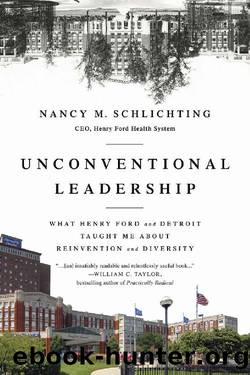Unconventional Leadership: What Henry Ford and Detroit Taught Me About Reinvention and Diversity by Nancy M Schlichting

Author:Nancy M Schlichting [Schlichting, Nancy M]
Language: eng
Format: epub
Tags: Business & Economics, Careers, General
ISBN: 9781351860574
Google: _RBODQAAQBAJ
Publisher: Routledge
Published: 2016-10-21T12:53:28+00:00
Incentivize Innovation
There are some innovations that donât cost much money. The tool that allows operating room nurses to access surgical instruments is a prime example: itâs an extremely useful, low-tech device that is important but inexpensive to design and produce. I like those kinds of innovations, but not everything comes on the cheap. When we pursued Dr. Menonâs robotic surgical solution, for example, we made the decision to invest in a cutting-edge operating room even as we were reducing costs pretty radically across the organization. Similarly, when we created the Innovation Institute we took $15 million out of our foundation to support the instituteâs setup and launch. When high-potential concepts present themselves, you need to pay attention.
No two innovations are alike. We pursue both mission-driven and commercially viable concepts. Mission-driven innovations aid us in our work as healers and are an important part of our responsibility as a teaching institution. Market-driven innovations, on the other hand, have commercial potential and, in theory, may offer a return on investment for the organization. Our award-winning hospital gown, for instance, is used not only in Henry Fordâs five hospitals and thirty-two medical centers, but is licensed for use by other hospitals in the U.S. and abroad. Interestingly, that was a concept we expected to be primarily mission driven but that turned out to be a bona fide commercial opportunity. Regardless of the return, people at Henry Ford will tell you that if a notable idea bubbles up, there is usually a funding path to be discovered.
Another, more unconventional way that we invest in innovation is by incentivizing employees for being creative and injecting a little competition into the mix. The HFHS intellectual property policy offers innovators a 50 percent share of future revenues that come from product ideas that end up in the market. Thatâs a pretty impressive call to action for employees who might have a great idea in their hip pocket. Our âInnovation Challengesâ are even more of a major draw. These ongoing contests, run by the Innovation Institute, target specific problems and opportunities in health care by engineering the collision of talent and resources. For example, in 2015 the institute sponsored a competition that called on HFHS employees to submit their best ideas for clinical applications of wearable technology. Employees were not only encouraged but also incentivized to participate, with $10,000 in prizes offered. Finalists competed for an investment of seed capital and commercialization support.
Winning entries included:
Download
This site does not store any files on its server. We only index and link to content provided by other sites. Please contact the content providers to delete copyright contents if any and email us, we'll remove relevant links or contents immediately.
The Data Detective by Tim Harford(1101)
100 Tricks to Appear Smart in Meetings by Sarah Cooper(798)
Mind Management, Not Time Management by David Kadavy(763)
GMAT For Dummies 2021 by Lisa Zimmer Hatch & Scott A. Hatch(698)
Amazing Decisions by Dan Ariely(643)
99 Financial Terms Every Beginner, Entrepreneur & Business Should Know (Financial IQ Series Book 1) by Herold Thomas(607)
The Smart Strategy Book by Kevin Duncan(536)
The Data Science Framework by Unknown(508)
The Store Detective Training Manual: A Practical Reference for Current and Aspiring Loss Prevention Officers by Glen Canarte(449)
Poor Students, Rich Teaching by Eric Jensen(432)
Cambridge IGCSE and O Level Business Studies by Karen Borrington(417)
Robert's Rules of Order by Henry M. Robert(414)
Arts, Sciences, and Economics by Tönu Puu(412)
Enterprise Analytics by Thomas H. Davenport(406)
Sustainable Education and Development by Unknown(396)
97 Things Every Information Security Professional Should Know by Christina Morillo(394)
Side Hustles: How to Make Extra Money Online by Hayden Vernon(384)
Excel 2016 for Marketing Statistics by Thomas J. Quirk & Eric Rhiney(373)
Information Literacy in Higher Education by unknow(352)
